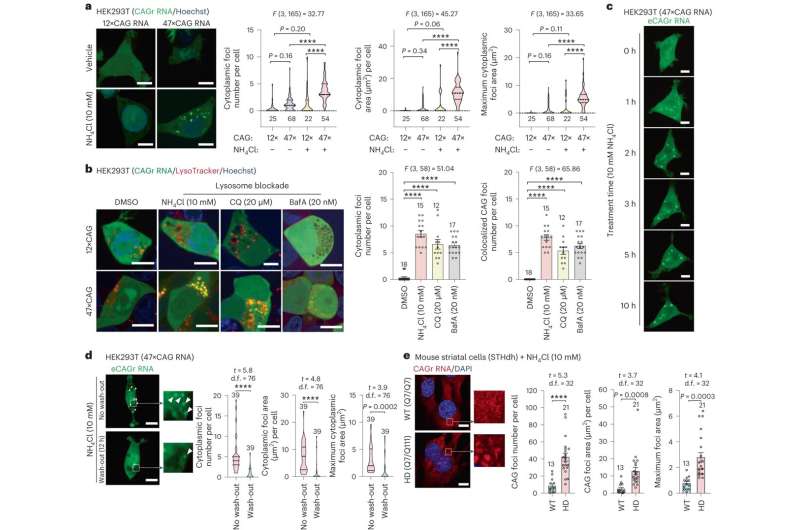This article has been reviewed according to Science X's editorial process and policies. Editors have highlighted the following attributes while ensuring the content's credibility:
fact-checked
peer-reviewed publication
trusted source
proofread
Study uncovers potential new source of genetic mutations that cause neurodegenerative disease

Scientists have discovered an additional potential cause of the genetic mutations that result in rare conditions such as Huntington's disease (HD).
The neurodegenerative diseases, which also include most spinocerebellar ataxias (SCAs), are known to be caused by an expansion in the CAG (cytosine-adenine-guanine) repeats within a gene that in turn leads to an expanded polyglutamine (polyQ) tract in a protein.
Such diseases are inherited, given that the expansion of CAG repeats in a gene can be passed down the generations.
Previously, it had been thought the damage in these genetic diseases was caused solely by increased protein aggregate toxicity.
However, a new study has found an additional source—ribonucleic acid (RNA)—can generate the levels of toxicity to cause damage to the brain in these diseases.
Published in Nature Chemical Biology, the research has revealed that expanded CAG repeat RNA can form RNA aggregates in the cytoplasm through a process called liquid-liquid phase separation and gelation. This reduces global protein synthesis, and leads to neurotoxicity and neurodegeneration.
The study is part of an ongoing international collaboration between experts in neuroscience and genetics from the University of Plymouth (UK), Fudan University and Tsinghua University (China).
Writing in the study, the authors say it significantly advances the knowledge available to those working to understand the cause of such inherited conditions.
They are also now planning to conduct further research to fully address the implication of expanded-CAG repeats RNA aggregate toxicity in patients.
The study was co-led by Shouqing Luo, Professor of Neurobiology at the University of Plymouth, and a world-leading expert in HD and other neurodegenerative diseases.
Professor Luo said, "Conditions such as Huntington's disease currently have few treatments and no known cure. If we are to make the significant steps needed to directly benefit patients and their families, we need to fully understand the nature of the conditions we are dealing with."
"This study marks a real step forward in what we know about the causes of Huntington's disease and other neurodegenerative conditions. It provides us with new mechanistic insights into diseases such as HD and SCAs that we can potentially use in the future to develop more effective ways of treating these conditions."
Professor Luo's work primarily focuses on establishing the processes through which HD develops and using that knowledge to find new ways of treating it and other diseases, including dementia.
His team has previously shed light on the mechanisms behind autophagy—a process through which cells work to destroy bacteria and viruses after infection—and how it progresses.
He has also established effective ways of facilitating the autophagy process, which results in the mutant huntingtin (HTT) protein in brain cells that causes HD is removed.
More information: Pan, Y. et al, Gelation of cytoplasmic expanded CAG RNA repeats suppresses global protein synthesis, Nature Chemical Biology (2023). DOI: 10.1038/s41589-023-01384-5. www.nature.com/articles/s41589-023-01384-5




















